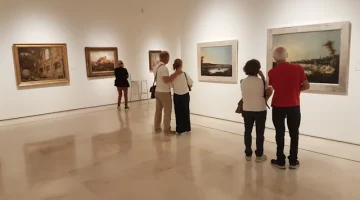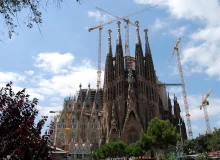Ten Best Things to See at MoMA
The Travel Guide recommends the ten best things to see at MoMA, one of the best museums in New York.

The Museum of Modern Art (MoMA) in New York City is one of the world’s most influential museums dedicated to modern and contemporary art. Since its founding in 1929, MoMA has amassed an unparalleled collection of paintings, sculptures, photographs, films, and design objects. With so many masterpieces on display, it can be overwhelming to decide what to see. Below are the ten best things to see at MoMA, each offering a unique glimpse into the evolution of modern art.
Ten Best Things to See at MoMA
1. Vincent van Gogh – The Starry Night (1889)
No visit to MoMA is complete without seeing Vincent van Gogh’s The Starry Night, one of the most famous paintings in art history. Painted in 1889 during van Gogh’s stay at the Saint-Paul-de-Mausole asylum in France, this swirling, dreamlike landscape captures the night sky over a quiet village with a luminous intensity.
Van Gogh’s thick, expressive brushstrokes and bold use of color create a sense of movement, as if the sky itself is alive. The cypress tree in the foreground stretches upward like a dark flame, while the stars and moon radiate with halos of light. Though van Gogh considered this work a failure at the time, it has since become a symbol of artistic genius and emotional depth.
MoMA acquired The Starry Night in 1941, and it remains one of the museum’s most beloved attractions. Its combination of beauty, emotion, and technical brilliance makes it a must-see for any art lover.
2. Pablo Picasso – Les Demoiselles d’Avignon (1907)
Pablo Picasso’s Les Demoiselles d’Avignon is one of the most revolutionary paintings of the 20th century, marking the birth of Cubism. This large-scale work depicts five nude women in a brothel, their bodies fractured into angular, geometric shapes with mask-like faces inspired by African art.
When Picasso painted Les Demoiselles, he broke away from traditional perspective and naturalism, instead presenting multiple viewpoints simultaneously. The painting shocked contemporaries with its raw, confrontational style and rejection of classical beauty. Today, it is celebrated as a turning point in modern art, influencing countless artists who followed.
MoMA’s acquisition of Les Demoiselles d’Avignon in 1939 solidified its reputation as a home for avant-garde masterpieces. Seeing it in person allows viewers to appreciate its radical composition and enduring impact on art history.
3. Salvador Dalí – The Persistence of Memory (1931)
Salvador Dalí’s The Persistence of Memory is the quintessential Surrealist painting, featuring melting clocks draped over a barren landscape. Painted in 1931, this small but mesmerizing work explores themes of time, dreams, and the subconscious.
Dalí’s meticulous technique creates a hyper-realistic yet dreamlike scene, where time itself seems to dissolve. The ants crawling on one clock and the strange, fleshy form in the center add to the unsettling atmosphere. The painting challenges our perception of reality, inviting viewers into Dalí’s bizarre imagination.
MoMA acquired The Persistence of Memory in 1934, and it remains one of the most iconic works in the museum. Its blend of precision and absurdity makes it a fascinating study in Surrealism.
4. Henri Matisse – Dance (I) (1909)
Henri Matisse’s Dance (I) is a vibrant, energetic painting that captures the joy of movement. Created as a preliminary study for a larger commission, this work features five nude figures holding hands in a swirling circle against a bold blue and green background.
Matisse’s use of simplified forms and intense color was groundbreaking at the time, paving the way for Fauvism and modern abstraction. The painting’s rhythmic composition conveys a sense of primal celebration, linking art to music and dance.
MoMA’s version of Dance (I) is a key piece in understanding Matisse’s evolution as an artist. Its dynamic energy and emotional power continue to captivate audiences today.
5. Frida Kahlo – Self-Portrait with Cropped Hair (1940)
Frida Kahlo’s Self-Portrait with Cropped Hair is a powerful statement on identity, gender, and heartbreak. Painted after her divorce from Diego Rivera, Kahlo depicts herself in a man’s suit, scissors in hand, surrounded by strands of her severed hair.
Unlike her usual colorful, folkloric style, this painting is stark and somber, reflecting her emotional turmoil. The lyrics of a Mexican folk song at the top (“Look, if I loved you, it was for your hair. Now that you’re without it, I don’t love you anymore”) underscore themes of betrayal and self-reinvention.
MoMA’s collection of Kahlo’s work highlights her unique voice in modern art. This self-portrait is particularly striking for its raw honesty and defiance of societal expectations.
6. Andy Warhol – Campbell’s Soup Cans (1962)
Andy Warhol’s Campbell’s Soup Cans is a defining work of Pop Art, blurring the line between commercial imagery and fine art. The series consists of 32 canvases, each depicting a different flavor of Campbell’s soup in a repetitive, mass-produced style.
Warhol’s fascination with consumer culture and celebrity is evident in this piece, which challenges traditional notions of artistic originality. By elevating everyday objects to high art, Warhol questioned the role of art in an industrialized society.
MoMA’s display of Campbell’s Soup Cans allows viewers to engage with Warhol’s commentary on mass media and consumerism. Its bold simplicity remains influential in contemporary art.
7. Jackson Pollock – One: Number 31, 1950 (1950)
Jackson Pollock’s One: Number 31, 1950 is a monumental example of Abstract Expressionism, showcasing his revolutionary “drip painting” technique. By pouring and flinging paint onto a large canvas laid on the floor, Pollock created a chaotic yet controlled web of lines and splatters.
This work embodies the spontaneity and physicality of Pollock’s process, where the act of painting became as important as the finished piece. The layers of black, white, and blue create a sense of depth and movement, drawing viewers into its dynamic energy.
MoMA’s Pollock collection is among the best in the world, and One: Number 31 is a standout example of his groundbreaking approach to art.
8. Claude Monet – Water Lilies (1914-26)
Claude Monet’s Water Lilies series represents the pinnacle of Impressionism, capturing the fleeting effects of light and nature. MoMA’s triptych version immerses viewers in Monet’s serene garden at Giverny, with floating lilies and shimmering reflections.
Painted in his later years, these works verge on abstraction, as Monet’s brushstrokes dissolve into pure color and atmosphere. The scale of the triptych envelops the viewer, creating a meditative, almost dreamlike experience.
MoMA’s Water Lilies is a testament to Monet’s enduring influence on modern art, bridging Impressionism and later abstract movements.
9. Marcel Duchamp – Bicycle Wheel (1913/1951)
Marcel Duchamp’s Bicycle Wheel is one of the first readymades, ordinary objects transformed into art simply by the artist’s designation. This piece consists of a bicycle wheel mounted on a stool, challenging traditional notions of craftsmanship and aesthetics.
Duchamp’s readymades were radical in their time, questioning the very definition of art. Bicycle Wheel invites viewers to reconsider the role of the artist and the value of everyday objects.
MoMA’s version (a 1951 replica of the lost original) is a key piece in understanding Duchamp’s influence on Conceptual Art and modern artistic practice.
10. Georgia O’Keeffe – Cow’s Skull: Red, White, and Blue (1931)
Georgia O’Keeffe’s Cow’s Skull: Red, White, and Blue is a striking meditation on American identity and the Southwest. The bleached skull floats against a bold, abstract background, symbolizing both death and endurance.
O’Keeffe’s precise, almost surreal depiction of natural forms elevates the skull to an iconic status. The patriotic colors add layers of meaning, suggesting themes of national pride and the harsh beauty of the American landscape.
MoMA’s O’Keeffe collection highlights her unique vision, and this painting remains one of her most powerful works.
MoMA Conclusion
MoMA’s collection is a treasure trove of modern and contemporary art, offering something for every visitor. From van Gogh’s emotional Starry Night to Warhol’s provocative Soup Cans, these ten masterpieces represent the bold creativity that defines modern art. Whether you’re a first-time visitor or a seasoned art enthusiast, these works provide an unforgettable journey through the innovations of the past century.
More Information
For opening hours etc visit the MoMA website.
More Information
For opening hours etc visit the MoMA website.




















